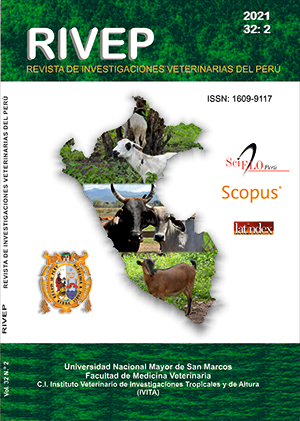Molecular characterization of segment 4 of lake tilapia viruses isolated from tilapia (Oreochromis niloticus) farmed in Peru
DOI:
https://doi.org/10.15381/rivep.v32i2.20016Keywords:
tilapia, TiLV, segment 4, RT-PCR, phylogenetic analysisAbstract
The aim of this study was the molecular characterization of segment 4 of the lake tilapia virus (TiLV) detected in farmed tilapia from the departments of Piura (Coast) and San Martín (Jungle) in an outbreak that occurred in 2017-2018. During this outbreak, 26 TiLV positive samples were obtained and five of them were selected. The diagnosis of these samples was carried out through a nested RT-PCR with primers directed to segment 3 and the PCR products were sequenced. For the amplification and analysis of segment 4 of the TiLV genome, an RT-PCR was performed where specific primers were designed. The sequencing was done by Macrogen (South Korea), by bidirectional sequencing using the automated Sanger method. The phylogenetic analysis was carried out from the aligned sequences by means of the Neighbor-Joining (NJ) method and the hypothetical protein characteristics of the gene was carried out with the Phyre2 program. Four sequences with a length of 1190 bp were obtained and compared with two sequences from Israel and one from Thailand, reference strains corresponding to segment 4 of TILV published GenBank. The phylogenetic analysis of segment 4 determined the presence of a local TiLV genogroup, in addition to indicating that the Peruvian samples have a greater genetic relationship with the clade of Israel strains. The genetic distance analysis shows that the Peruvian samples have nucleotide identity values of 99.7-100% between them, determining that the outbreaks of both locations were produced by the same viral strain, and have an identity of 97.5-97.7% with strains from Israel and 97.0-97.1% with strains from Thailand. The hypothetical protein from TiLV segment 4 was determined to have structural homology to the neuraminidase N6 protein from English duck influenza A virus with 12% coverage, 44% identity, and 24.9% confidence.
Downloads
Downloads
Published
Issue
Section
License
Copyright (c) 2021 Shirley Palacios H., Alberto Manchego S., Gina Castro S., Antonio Herrera R., Adhemir Valera A., Nieves Sandoval C.

This work is licensed under a Creative Commons Attribution 4.0 International License.
AUTHORS RETAIN THEIR RIGHTS:
a. Authors retain their trade mark rights and patent, and also on any process or procedure described in the article.
b. Authors retain their right to share, copy, distribute, perform and publicly communicate their article (eg, to place their article in an institutional repository or publish it in a book), with an acknowledgment of its initial publication in the Revista de Investigaciones Veterinarias del Perú (RIVEP).
c. Authors retain theirs right to make a subsequent publication of their work, to use the article or any part thereof (eg a compilation of his papers, lecture notes, thesis, or a book), always indicating the source of publication (the originator of the work, journal, volume, number and date).










